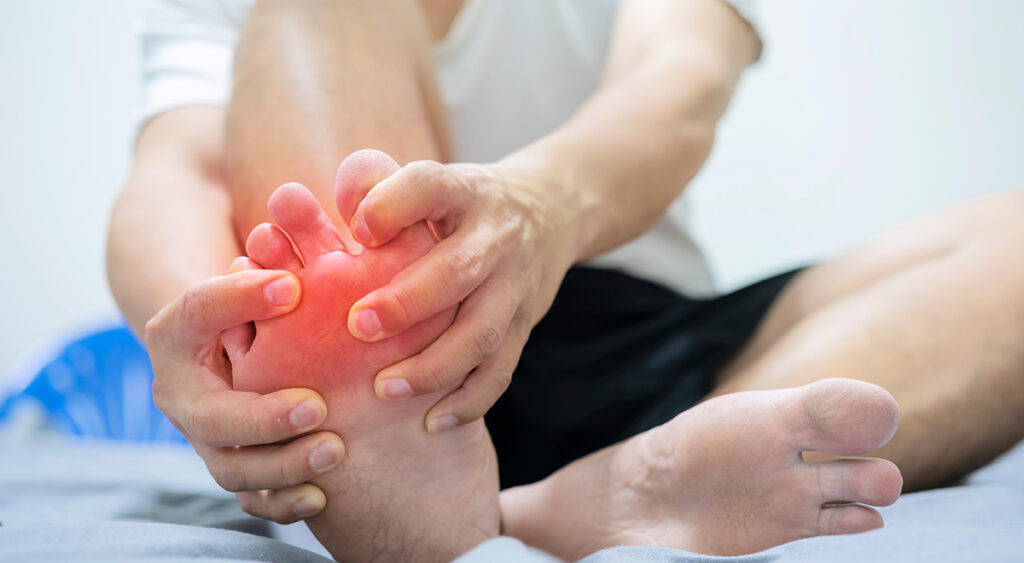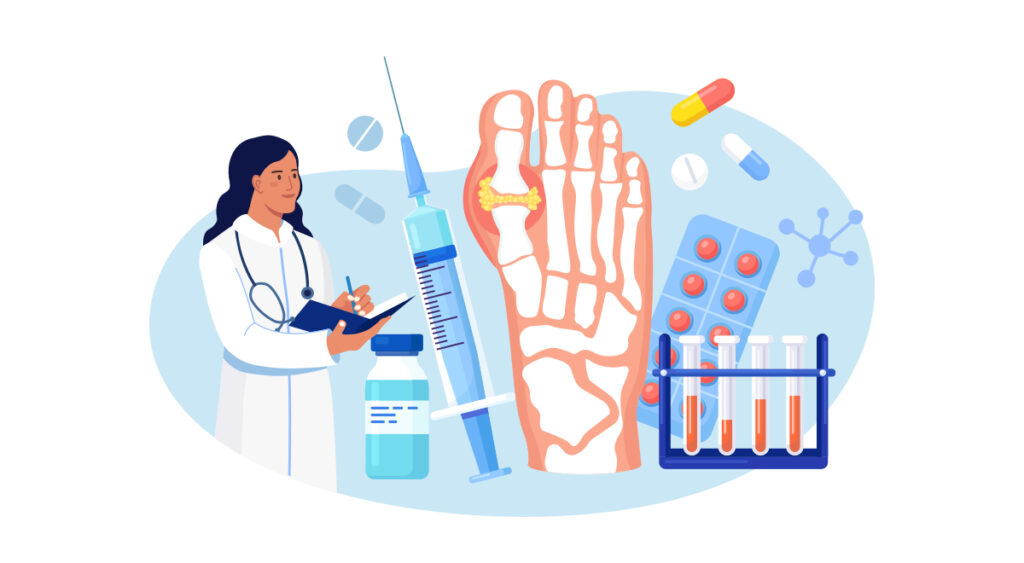Gout is a form of arthritis that causes pain and inflammation in the joints.
While there is no cure for gout, you can manage symptoms and slow down the progression of the disease to regain your normal life. To do this, you will need to understand the symptoms, causes, and treatment options.
Today we will talk about these and more!
What is gout?
Arthritis has many different forms, and gout is one of them. It’s an inflammatory disease caused by uric acid buildup in the body. This urate can form sharp little crystals in the joints resulting in pain flare-ups. At the same time, white blood cells will try to break down these crystals, producing toxic chemicals in the process, leading to inflammation and further discomfort.
While gout is incurable, it is possible to manage the progression and symptoms with certain medications and lifestyle changes.
Types and stages of gout

With gout, we can differentiate between primary and secondary gout. Primary gout is when the disease appears without any other underlying cause. Secondary gout, on the other hand, is usually either caused by some chronic kidney condition or might be a side effect of long-term medications.
Gout usually goes through different stages, progressively getting worse.
The first one is called asymptomatic hyperuricemia. As the name suggests, uric acid is already building up in the body, but the characteristic symptoms of gout are not apparent yet. At this stage, one has to focus on slowing down the further progression of the disease, usually by making some lifestyle changes.
The second stage of gout is called acute intermittent gout, where uric acid starts to form crystals in the joint, causing pain flare-ups. These attacks usually last for a few days at a time. During this stage, you may experience pain, swelling, stiffness, and redness around the joint.
The disease then progresses to an advanced stage called chronic tophaceous gout. By this time, the urate crystals might have already damaged the cartilage and bones in the joint. The pain might get worse and more frequent.
While it’s not a form of gout, we should also mention pseudogout. It has similar symptoms to gout, hence the name. The difference lies in the underlying issue, as the cause of gout is uric acid buildup, while pseudogout results from abnormal calcium pyrophosphate deposition.
Gout symptoms
Similar to most other types of arthritis, the main symptom of gout is joint pain. This pain usually comes in the form of sudden flare-ups that might last for days at a time.
Patients with gout might experience the following symptoms in the joint area:
- Intense pain
- Sensitivity to touch
- Red, shiny skin
- Swelling
- The joint feels hot
- Tenderness
- Occasionally fever
The pain flare-ups or gout attacks follow an unpredictable but very characteristic pattern. They often start at night and can get worse over the course of several hours. Depending on the stage and severity of the disease, attacks might last from a few days to a few weeks.
The frequency of the attacks is usually unpredictable, but they will occur more often and with stronger symptoms as the disease progresses to later stages.
Gout usually affects only one joint at first, often the big toe. But over time, you might experience similar symptoms in other joints too.
It’s crucial to keep an eye on your gout symptoms, as it is possible to have multiple forms of arthritis at the same time. For example, a high fever alongside the above symptoms might indicate septic arthritis resulting from an infection that needs immediate treatment.
Diagnosing gout
Gout’s telltale symptoms usually make it easier to diagnose.
However, it is paramount to rule out other forms of arthritis, as they can occur simultaneously. And we should not forget about pseudogout either, a similar disease but with a different underlying cause.
X-ray and ultrasound imaging tests can help visualize the uric acid crystals and rule out other possible causes of joint inflammation. While blood tests can reliably display high levels of uric acid in the bloodstream, this doesn’t necessarily lead to gout in every case. For this reason, joint fluid might be drawn and examined for urate crystals.
Doctors will also try to rule out kidney problems, as some of these can be an underlying cause of gout and lead to further problems.
An early diagnosis can help slow down the progression of the disease and better manage the symptoms. This can be achieved by lifestyle changes and often medication.
Gout causes
Purine is a substance that occurs in the body and different foods, such as certain kinds of seafood, some meats and organs, and some forms of alcohol. When the body breaks down purine, it produces uric acid, a natural waste product. Then the kidneys filter it from the bloodstream, and it leaves the body through the urine.
The problem arises when either there’s too much uric acid in the body, or the kidneys fail to get rid of it properly. These may cause high levels of urate in the bloodstream, called hyperuricemia.
In some cases, this urate buildup accumulates around the joints, forming sharp little crystals. That is what we call gout.
Certain factors can increase the risk of developing gout.
Purine, and therefore uric acid levels can be affected by our diet choices. Foods that cause gout are red meats, some kinds of seafood, fructose, and some alcoholic beverages like beer. Avoiding these can reduce risks and slow down the progression of already-developed gout.
Maintaining a healthy weight and exercising are very important with all sorts of arthritis as these will reduce the stress on the joints by putting less weight on them and strengthening the muscles in the surrounding areas.
Some medical conditions may also increase the risk of gout. Kidney conditions can affect the breakdown of uric acid in the body. Diabetes, high blood pressure, and some heart diseases may also increase the risk.
Other risk factors are beyond our control, like family history, age, and sex. Gout is more common and usually develops sooner in men. Gout in the family also increases your risk.
Gout treatment

When deciding on treatment options, it’s crucial to differentiate between primary and secondary gout. Secondary gout is caused by an underlying health issue, a kidney disease, for example. In this case, treating the underlying problem should be prioritized.
Regardless of the cause, slowing the progression and treating the symptoms are equally important. An early diagnosis can increase your chances of delaying the more severe stages of the disease.
The goal of gout treatment is usually twofold. We need to relieve the pain. And we need to lower uric acid levels in the body to slow down the progression of the disease.
Let’s look at the possible treatment options for gout.
Medication
For pain relief, doctors may prescribe different types of medicines, depending on the severity of the pain. In mild cases, analgesics or nonsteroidal anti-inflammatory drugs (NSAIDs) may be used. In more severe cases, corticosteroid or colchicine treatments might be recommended.
To lower uric acid levels, doctors can choose from a range of available medications, such as Allopurinol, Febuxostat, Pegloticase, Anakinra, or Canakinumab.
Lifestyle changes and diet
As with other forms of arthritis, staying active and maintaining a healthy weight can help slow down the progression of the disease.
One should follow a gout diet that reduces purine intake. It’s recommended to avoid the following foods as much as possible: high-fructose corn syrup, fatty meats, dairy products, organ meats, shellfish, anchovies, sardines, and alcoholic beverages.
Surgery
In severe cases, gout might cause irreversible damage to the joints. While surgery is a more drastic measure, doctors might advise it if a later stage of gout impacts the quality of your life severely.
It’s possible to surgically remove the uric acid crystals from around the joint. In cases of permanent damage, joint fusion or replacement surgery might be necessary.
Pain relief without the side effects
Pain is one of the major symptoms of gout. It affects your movement, your mood, and your everyday life.
Managing the pain flare-ups is not always easy. Painkillers and other medicines often come with undesired side effects, and alternative pain relief options are not always as effective.
Let me introduce to you our one and only Freedom SuperPatch! An effective pain management solution designed to be entirely drug-free, with no side effects. On its own or combined with other treatments, the Freedom pain patch will provide immediate gout pain relief during flare-ups.
